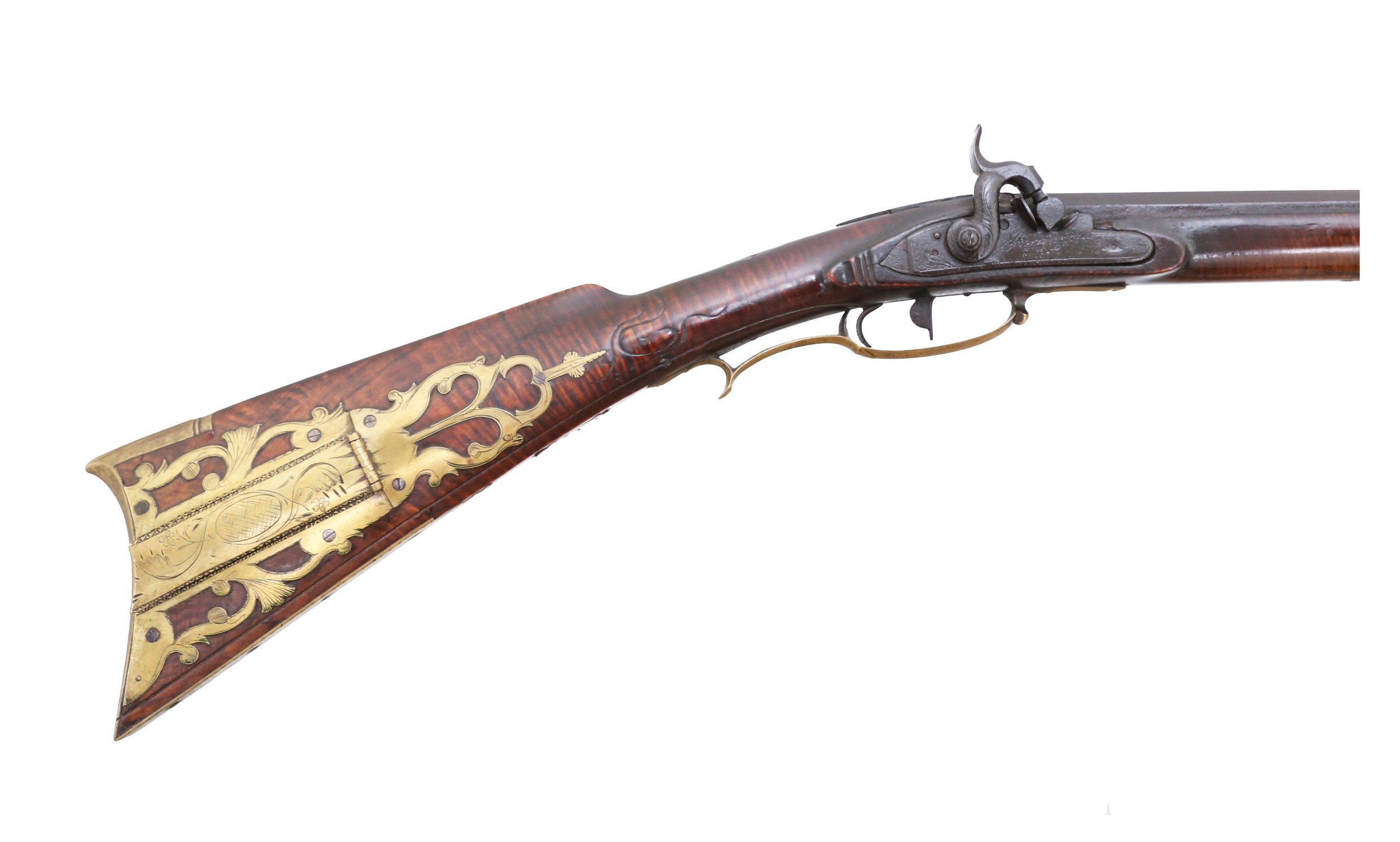The W. & R. Bell Rifle of Bracken County, Kentucky ©
Foreword: The finest rifles made in Kentucky came from its “golden age” during the late flintlock era from about 1800 until 1830. Major gunmaking centers in Lexington, Bardstown, and along the Ohio River above Louisville produced most of the state’s finest early rifles. Generally, Bardstown produced the most artistic rifles while Lexington made the most understated and gracefully stocked rifles. But Kentucky’s Ohio River School above Louisville, while less prolific, could make an exceptional rifle when the need arose. One of Kentucky’s outstanding early rifles is the “W. & R. Bell” rifle of Bracken County, made by brothers William and Richard Bell about 1820. Most known Bell rifles are neatly stocked but lack decoration with several being made in the “poor boy” style without a butt plate, nose cap, or rear ramrod pipe. Despite most of the Bells’ work being plain, the two brothers possessed much greater gunmaking skills. Two exceptional rifles are known, fully mounted with elaborate patchboxes, well-engraved coin silver inlays, touches of incise carving, and superb stock wood and architecture. The better of the two rifles is illustrated below. It is one of Kentucky’s finest early rifles, dates to about 1820, and while now percussion, retains its original flintlock plate and a vent pick inlay/hole in the butt’s bottom edge verifying an original flint ignition. The second noted fine rifle, similar in mountings and stocking, is dated “1821” on the cheekpiece inlay. However, it is a restock by the Bells of an earlier Kentucky-made rifle [only the earlier rifle’s signed barrel was salvaged] and therefore does not carry the Bell brothers’ joint signature.
Figure 1: A full length view of the Bell rifle highlights its graceful stock architecture, elaborate brass patchbox, and silver inlay work.
The Bells: Richard Bell was born in Mason County, Kentucky, in 1795 and brother William in 1797. Their father, Richard Bell Sr., may have been a gunsmith but it remains unverified. He was an early settler and farmer of Mason County who moved his family to nearby Bracken County in the early 1800s and died there in 1811. As adults, the two Bell brothers lived next door to each other in Bracken County and were listed as farmers in most census data. Only in 1870 was Richard listed as a gunsmith working at Brooksville in Bracken County. Their guns are rare, with the author seeing only four signed examples in the last 40 years. All known rifles are brass mounted, well-stocked with slender, attractive stock architecture, and have joint signatures cut into the barrel iron. Only the two finer rifles mentioned above have patchboxes and inlay work; all other known rifles are generally plain “working” rifles.
Figure 2: The Bell rifle’s patchbox is heavily pierced and well-engraved with the Kentucky “stemmed ball with point” finial indicating the gun was made on or near the Ohio River. Incise carving decorates the wrist and rear of side facing, a rare Kentucky detail.
Figure 3: The reverse of the Bell rifle shows the wrist carving clearly, incised/slashed detail at rear of side facing, fancy side plate with an engraved “false” front lock bolt, and the large cheek inlay engraved with a fine federal eagle.
The Bell Rifle: It is hard not to lavish superlatives on the Bell rifle when viewed in-hand. All aspects of construction are well-done. Inlay work uses several shapes unique to the Bells’ hands; engraving is deep and well designed; stock wood was selected from a curly maple blank cut low on the tree near the root so the grain curves with the wrist area of the gun, making it almost unbreakable. Incise carving decorates the rear ramrod pipe and wrist areas, a rare feature on Kentucky-made guns with the most notable exception being the Bardstown rifles. The rifle’s most decorative detail is its large, fully engraved brass patchbox with seven piercings and a “stemmed ball with point” finial denoting an Ohio River gun made from Louisville to points east, or up-river. Other noteworthy details include: 1) a full side-plate with Kentucky “horns” on either side of the lock bolt and a faux screw-head engraved at the front end of the plate; 2) silver barrel plate engraved “W. & R. BELL” in large script letters; 3) silver fish-shaped inlays at the three forward wedge positions; 4) the most intriguing detail on the rifle, a well-shaped Indian head inlay [Figure 4] at the first barrel wedge with headband and scalp-lock or topknot on the head; 5) large oval cheekpiece [Figure 5] inlay of coin silver engraved with a federal eagle [eagles were rare on Kentucky guns]. A more detailed description of the gun is available in Kentucky Gunmakers 1775-1900, Epilogue, but the following pictures will acquaint the reader with the overall beauty and artistry of the Bell rifle and its many fascinating details, several of which are unique to Kentucky’s riflemaking. Truly, the “W. & R. Bell” rifle is one of the finest known muzzle-loading rifles made in the State of Kentucky, and an exceptional example of the artistic capabilities of the State’s early pioneer craftsmen.
Figure 4: A coin silver forestock inlay in the shape of an Indian head with top knot and head band protects the first barrel wedge. It is the most unique inlay on the Bell rifle, doesn’t appear on the other fine Bell rifle, and is probably the only inlay of this type on a Kentucky gun.
Figure 5: The Bell rifle’s silver cheekpiece inlay has a well-engraved federal eagle with a “reeded” edge around the edge, similar to the reeded edge of a coin. Eagle inlays are rare on Kentucky guns. The fine figure, or curl, in the Bell rifle’s maple stock wood is highly visible in this view.





